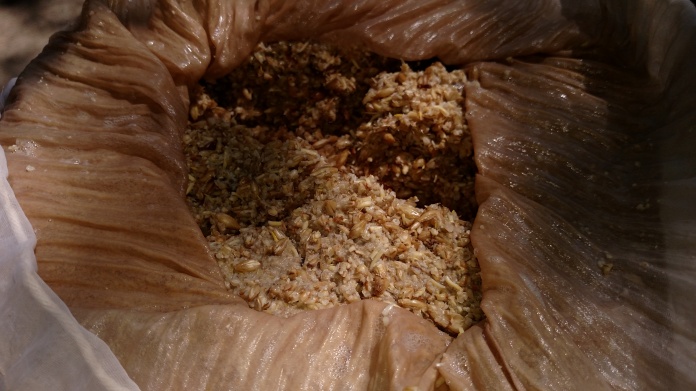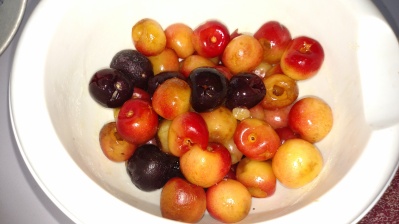
Brew in a Bag set up (BIAB)…draining the grains
A friend recently asked if I would be interested in joining her in providing a homebrew for an event. The event is just prior to the local soccer team’s game. The team is the Carolina Railhawks, so I’m making a beer I’m calling Railer’s Pale Ale. Hopefully, my friend will be able to get my beer into a keg and we will set up beside each other to serve our beers. If the keg doesn’t work out, I can always bottle.
I used an online recipe building program, armed with a basic idea that I wanted to use some frozen, vacuum sealed Cascade hops for the bittering/background “canvas”, with a combination of Mosaic and Citra hops for flavor and aroma. The Mosaic add a resinous flavor and the Citra are, surprise! citrusy.

Cascade whole hops that had been vacuum sealed and frozen.

Starting the 60 minute boil with the Cascade hops.
The base grain is an American 2-row. In playing with other grains to get the right alcohol ABV and the right color, I picked a few specialty grains. Then, after a little research, Wyeast American Ale II 1272 “smack pack” for the yeast. At the lower recommended temperature range, it is supposed to produce a clean, crisp result that accentuates the citrus componants. I went ahead and took the yeast out and activated it early on.
I put my recipe out for some fellow brewers to look at, but didn’t get any feedback before I had to go pick-up the ingredients. After I milled the grains and came home, I see a note from an experienced brewer who said I had too much specialty grain (28% of the grain bill) and should cut them in half and make up the difference with more 2-row. Ugh. The comment is that the beer will be too sweet. Well, I’m kind of stuck now. I can’t waste the time or money on buying more grain for a beer that is going to be given away. Ah, well. I hope that the hop selections will help counteract some of the sweetness that I’m being told is going to be there. At the very least, it will be beer, and it should be drinkable. Mine may not be picked by the fans as the best one there, but I’m not expecting to be in that group anyway…I’m probably the novice of the group.
So, without going through all the individual brew steps here, I’ll hit just a few points. The brew went pretty well as far as the step go. The mash temperature was overshot, as I usually do, not matter how careful I try to be. I used a little Culligan water, cold, to bring the temperature down into my target range. And flies and bees started showing up to check out the wort. Really got to be irritating! Otherwise, no problem with my little modified sparge or the boil.

My little modified sparge set-up.
I do need to note, that being a Liberal Arts guy, “brewhouse efficiency” and some of the more technical calculations in the process are pretty much a guessing game for me. I had the efficiency at 63% in the recipe, based on a previous brew that seemed fairly accurate. When I checked the specific gravity (SG) between the mash and the boil, I got 1.054. The post boil gravity was only supposed to be 1.052, so my efficiency was more like 71%. I adjusted it in the recipe, and the end result will be just a little higher alcohol content,,,but not crazy. It will still only be (estimated at this point) 5.15% ABV. That should be fine.
I chilled with an immersion coil. The tap water temperature is 71F, so I knew I wouldn’t get the wort down into the low 70’s.

Stainless steel coil immersion chiller in use.
I managed 83F and transferred to the carboy…started off using siphon, but the whole hops were a challenge and I wound up having to hand-pour about 1/3. A bit messy, but couldn’t be helped.

Siphoning wort into the carboy (on top of my little chest freezer converted to fermentation chamber).
I put the wort in my fermentation chamber with an airlock installed, and placed the package of yeast in as well. I let the wort continue to cool for a few hours and then pitched the yeast.
After a couple of hours, I realized the temperature was a little low, so I turned the thermostat up a few degrees and left the lid up on the box to bring the temperture up for awhile. Six hours later, I see the slightest indication that the yeast may be active. A few hours later, I closed the lid to keep the temperature in the range I want, which would be around 65-68F. Now we wait to see if it really takes off…and how it turns out.
Update: 7/23/16 Checked on the progress around noon and we have a good fermentation in progress!

Success!














































